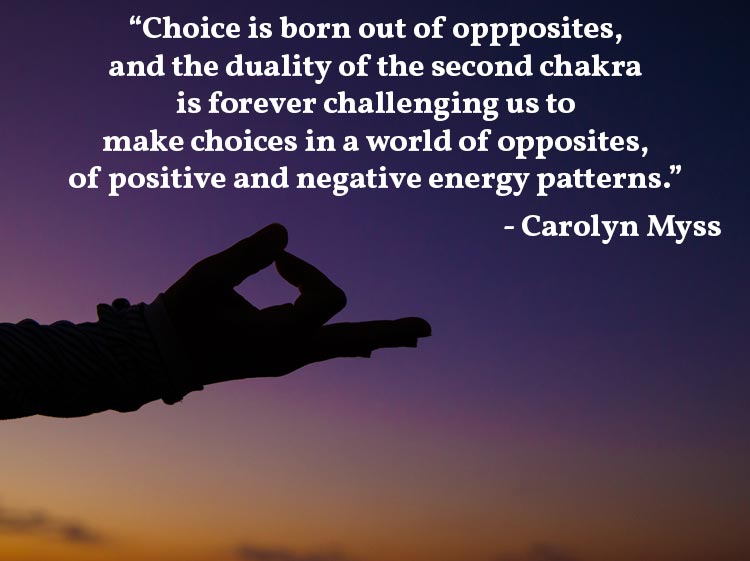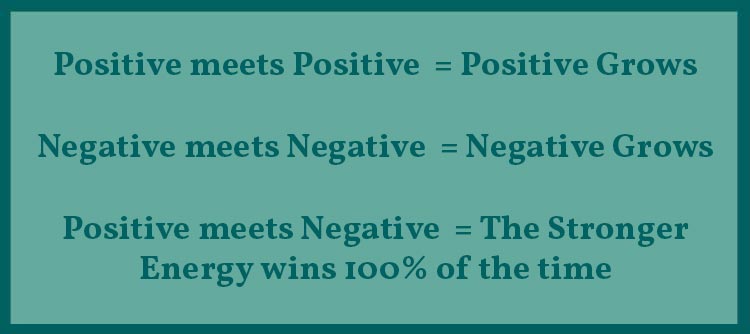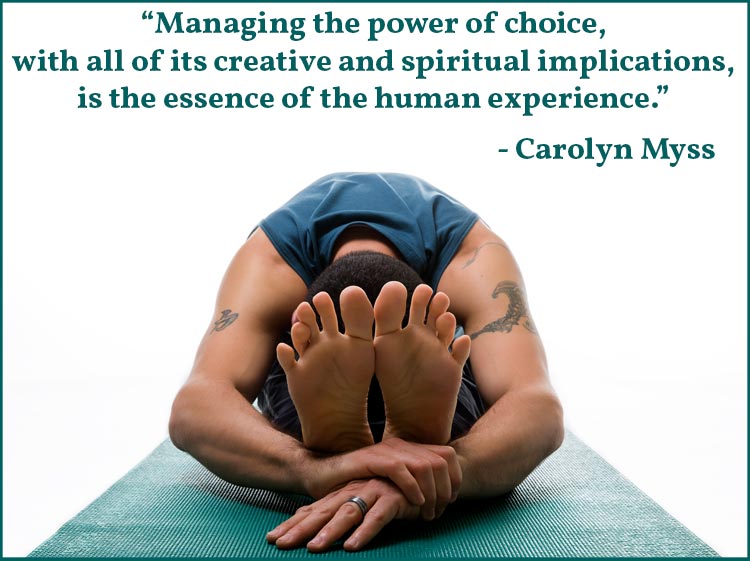 The foundation of a successful yoga business is high-quality relationships. But what happens when you encounter the negative, angry yoga client? Instead of losing your personal power, learn to remain centered and confident in those interactions. This article–which is the second in a three-part series on how to handle challenging students–will reveal simple steps to stay positive amidst negative people. The end result is that you can keep more abundance, grace, and ease flowing through your yoga business.
The foundation of a successful yoga business is high-quality relationships. But what happens when you encounter the negative, angry yoga client? Instead of losing your personal power, learn to remain centered and confident in those interactions. This article–which is the second in a three-part series on how to handle challenging students–will reveal simple steps to stay positive amidst negative people. The end result is that you can keep more abundance, grace, and ease flowing through your yoga business.
I’d like to share an example from my client who encountered such a challenge a while back. She had invited in an outside teacher to her studio for a weekend workshop. The problem was that the actual event fell far short of what was advertised. This left many students disgruntled and upset. There were even a few who got angry and wanted a refund.
She utilized many of the tools outlined in this article to stay centered amidst the situation. And, she learned how to improve her communication skills to prevent misunderstandings from happening in the future.
Photo Credit: Sharon Wright
THE SECOND CHAKRA AND RELATIONSHIPS
The second chakra, also known as swadhisthana, is the partnership chakra. It’s the energy center that allows us to understand our sense of individuality amidst a sea of unique humans. For we’re all different and have a unique perspective about the world. It’s through this contrast that you learn how to make choices more consciously. This is especially true in your relationships.
When in balance, a healthy second chakra acknowledges your unique strengths around others. You are confident in your own personal power and your ability to thrive in the world. With this inner knowing, you can more readily take risks and recover should you experience any loss.
When the second chakra is out of balance, you can feel powerless. It may seem that other people or forces control your life and that you don’t have the skills necessary to support your growth.
Code of Ethics
Swadhisthana is often referred to as the ethical center of body. This is similar to your moral compass. Essentially, the code of ethics based in your second chakra guide your actions in a relationship. They also communicate what you will, and will not, accept from others. Plus, they serve as a warning bell if you ever veer away from your inner values.
It’s also important to note here that shared morals can bond individuals together. This can be the glue that binds your yoga community around a core purpose or shared mission. On the flip side, a breach of those values can tear relationships apart. The end result depends on how you handle these differing opinions.
Clarity in Opposites
You are continually assessing your own strength by your experiences in the external world. When you experience relationships that are uplifting and positive, you reinforce the natural energy of the second chakra that honors one another.
Yet when you face a challenging situation, such as an angry yoga client, the experience can be clarifying. It can help you discover more of what you want in your life–or what you don’t want. You can also have the choice in the moment to use any discord to become a more conscious human being. With this level of awareness, you remain in your personal power–regardless of your external circumstances.

Photo Credit: Casey Brooke Photography
WHICH ENERGY WINS?
While the second chakra inclines us to be in control of our lives, the reality is there are many elements of the external world beyond our control. You will encounter positive people and circumstances as well as negative. The goal is to learn to manage our inner world and manage our emotions in the face of any external stimuli.
Since positive and negative energy streams are constantly in flux, how do you know the outcome when they meet one another?
Positive meets Positive
When positive energy meets positive energy, that positivity swells. You notice this when you’re in a good mood, and you teach an amazing class, and you chat with sparky clients afterward who want to share all of the great insights they’ve had or what is going well in your life. You leave that interaction on an energetic high.
Negative meets Negative
When negative energy meets negative energy, that negative energy grows stronger. You’ve probably also experienced this when one thing goes wrong in your day, and then you notice a domino effect of that misfortune. For example, you could have spilled coffee on your new clothes right before heading to teach. Then, the computers don’t work when you get there and you have an angry yoga client who wants to complain about the parking. Your inner angst is made worse with each negative encounter.
Positive meets Negative
But what happens if positive energy meets negative energy? What happens if you’re in a great mood and you encounter an unhappy student? Whichever energy is stronger wins 100% of the time!! That’s why it’s so important to keep yourself in a centered, grounded, and positive space! With practice, you to be able to remain in this energy as you more easily navigate challenging situations with others. You can role play this on your own or at a yoga staff meeting. The tools below will also help you remain positive.

CREATE A WHOLE BRAIN STATE
In a perfect world, the right and left hemispheres of your brain would work together as you face life’s circumstances. Your left brain would logically analyze the information from the world around you, and let you decipher detailed data. To balance this out, the right brain would understand those pieces of data in the bigger picture and make emotional sense of your experiences.
Yet, when you face stress or unwanted circumstances, one hemisphere or the other tends to shut down. To prevent this from happening, you can create a whole brain state. This keeps The the lines of communication open between these two hemispheres even in the face of discomfort.
Benefits of a Whole Brain State
- The mind is calm
- You learn new things more easily
- Information stored in your memory is easily recalled
- You make decisions with more clarity, and
- Your awareness and creativity increase
STAY WHOLE-BRAINED AROUND ANGRY CLIENTS
There are numerous ways you can get into a whole brain state. Doing so when you are working with upset students can allow your own energy to remain high during a conflict. This will help you stay focused and clear-minded to find a solution that will work best all concerned.
Cross your limbs
The easiest is to create a cross-over pattern in the body–like crossing your arms. In fact, you probably already do this very naturally when you want to conserve energy. If you are talking with a client one-on-one, you can casually cross your arms (or even cross your legs, too, if seated) to remain centered.
When you combine this cross-over pattern with some deep breaths, you amplify your personal power in the moment.
Look at a crossover pattern
It’s no mystery why most religious symbols include a crossover design–such as the cross for Christians, the Star of David for Jews, or the Dharma wheel for Buddhists. Each crossover pattern helps induce a whole-brain state of equanimity and balance.
When you are face-to-face with an angry yoga client, find a crossover pattern on their face. There won’t be an actual line drawn there, but the natural features of the face can resemble an “X” shape.
By seeing this imaginary “X,” you can still look the other person in the eye to demonstrate respect. Yet at the same time, you can be using the crossover pattern to stay centered in your own positive energy. (And, again, breathing deeply while you converse also helps!)
Draw a crossover design
Throughout my years in school, I would constantly doodle swirly designs in my notepad when listening to a lecture. This would help me stay focused and alert, even when lots of information was coming my way. In fact, I could pick out the important points more easily, too.
So, when you are dealing with an angry yoga client over the phone, you could have a piece of paper handy and draw some crossover designs while you are listening to them. This will help you hear their concerns while not taking on the negative energy of their complaints. It’s as though you put up an imaginary shield that protects you from unwanted influences.
Photo Credits: Julie Johnson, Stephanie Nakagawa, Lauren Rader
COMMUNICATE WITH CLARITY
From this whole brain state, you will be able to more clearly articulate your ideas verbally to an angry yoga client.
Validate your client’s feelings
Most people who are upset just want their opinion to be heard. When you master the skill of listening, you can hear what others have to say without taking on the energy behind their words. One way to validate the feelings of an angry yoga client is to:
- Remain quiet while you hear them out. This honors them for their unique experience, even if they chose to be negative.
- Repeat back what you heard them say. All you have to do is summarize the message you just received and ask them if you are correct. This simple act will ensure you both are on the same page and will validate the student has been heard.
- The client can then respond by confirming you are on the same page or by modifying their complaint. In either case, this 3-step process slows down your communication so that a mutual understanding can take place.
From there, you can work toward a solution to the issue at hand.
Ask questions
This allows you to discover the heart of their concerns. Ask, “Can you explain to me the source of your concern?” or “Can you email me your concerns in writing? I will then be able to look for a solution.”
Get their concerns in writing
One of the best ways to have clients take responsibility for their opinion is to have them put their concerns in writing. Ask them to email you directly with their complaint. You can also request they suggest two or three ways to resolve the problem. This will give you direct insight into their thoughts and ideas about a solution.
Buy some time
If you don’t have a solution after listening to your client, then buy yourself some time to find a solution. When in person, simply ask if you can have some time to think about a way to solve the problem. Then set a time to meet or discuss this again at a later date.
Or, if you’re on the phone with an upset customer, step away from the situation to get a grip. Place them on hold. Take a few deep breaths. Consider your options without being bombarded by their negativity. And, if no solution comes to mind in those few moments, buy more time by requesting to call them back later or when you have a solution to offer.
 Put yourself in their shoes
Put yourself in their shoes
Thanks to the moral compass of your second chakra, you want to honor others. One of the best ways to do this is to put yourself in their shoes for a moment. From that vantage point, you might be able to come up with new ideas to solve the problem. Ask yourself:
- How would I feel if I were in a similar situation with another company?
- What resolution could make this right for me as a customer?
- How could me, as a consumer, as well as the business owner walk away feeling good about the situation?
Running a yoga business is all about customer service. You want to make your yoga clients happy, yet you don’t want to cross your values to do so. By putting yourself in the shoes of an angry yoga client, you might just be able to discover a win-win solution for all.
Break Rapport
A relationship is a two-way street and it takes both parties to be in harmony. If an angry yoga client is unreasonable or abusive or simply unwilling to listen, then it’s time to break rapport. Or if you can’t hold to your centered space in the discussion any longer, end the conversation. You do this on a subtle level when you buy time. Yet sometimes you need to be more straightforward.
Most importantly you want to stay in charge during these instances. Stay respectful and responsible. You can do this in three basic ways:
Take ownership of your portion
Own up to your part in the issue, and then send them elsewhere. “I wish it could have been different for you, and I’m sorry you’re upset. I don’t think we are able to meet your needs at this time and I think it would be better if you found another yoga home.”
Learn from the situation
I had a client that invited in an outside teacher for a weekend workshop. The problem was that the actual event fell far short of what was advertised. This left many students disgruntled and upset. There were even a few who got angry and wanted a refund. After putting herself in their shoes, she was able to meet the angry yoga clients halfway and give them a 50% refund. It hurt her pocketbook in the moment, but she learned to be more particular about scheduling events for the future.
WHAT ABOUT THE SILENT, ANGRY YOGA CLIENT?
What if you have a client who comes in without a smile on their face? You can tell they are upset about something, but they don’t talk directly about the source of their suffering. Instead, they complain about anything and everything.
Even when the topic seems harmless enough, they’re able to put a negative spin on the conversation. You often want to run from these clients because their toxic energy drains whatever positive reserves you have in store.
Remember that these clients need compassion. They want attention. Diffuse their bad vibes by:
- Asking them a direct question, like “It seems that you are not feeling your best today. Is there anything I can do in class to make you feel better?”
- Listening
- Encourage them with a phrase like, “Let’s see if we can get a smile on your face by the time you leave the room!”
If their negativity becomes too much, then you can always break rapport like in the examples above.

Photo Credit: Diane Nicole Photography
PUTTING IT TOGETHER
As a yoga professional, you will inevitably face an angry yoga client now and then. When you keep your positive energy levels high, your positivity can outweigh their negative mood. You can get in a whole-brain state to remain centered. Then from this place of balance and personal power, you can listen without taking on the problems of your students. And, you can clearly articulate your point to shift the direction of the interaction.
If an angry yoga client just doesn’t want to find a solution with you, you can always break rapport! Harmony in a relationship takes two! And saying goodbye to these unhappy clients can sometimes be the best move for your yoga business as a whole.
One Final Note
This article was written as a direct response to a question asked by a member of our Swagtail community. Do you have a topic you want covered on our blog? Are you looking for answers to a specific problem in your yoga business? Contact us directly or leave a comment below! We’d love to be part of the solution you seek!











Leave A Comment